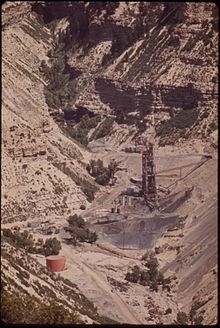Oil Shale Strategy

Humans have used oil shale as a fuel since prehistoric times, since it generally burns without any processing. Oil shale, also known as kerogen shale, is an organic-rich fine-grained sedimentary rock containing kerogen (a solid mixture of organic chemical compounds) from which liquid hydrocarbons called shale oil (not to be confused with tight oil—crude oil occurring naturally in shales) can be produced. As part of President Obama’s strategy to continue to expand safe and responsible development of the nation’s energy resources, Secretary of the Interior Ken Salazar today announced the Department’s final plan for encouraging research, development and demonstration (RD&D) of oil shale and tar sands resources on Bureau of Land Management (BLM) lands in Colorado, Utah and Wyoming. The Record of Decision and plan amendments make nearly 700,000 acres in Colorado, Utah and Wyoming available for potential oil shale leasing and about 130,000 acres available for potential tar sands leasing in Utah.
The largest known domestic oil shale deposits are in a 16,000-square
mile area in the Green River formation in Colorado, Utah and Wyoming.
Oil shale can be mined and heated to an extremely high temperature
(retorting) in above ground facilities, and the oil can then be
separated from the resulting liquid. Oil shale also can be subjected to
extreme heat and pressure while in underground formations (in situ
retorting) and the resulting liquid pumped to the surface. The final oil
shale plan examines surface mining with surface retort, underground
mining with surface retort, and in situ retorting technologies.
Global technically recoverable oil shale reserves have recently been
estimated at about 2.8 to 3.3 trillion barrels of shale oil, with the
largest reserves in the United States, which is thought to have 1.5—2.6
trillion barrels. Worldwide production of shale oil was estimated at
11,600 barrels per day in 2002. The leading producers were Estonia
(5,500 barrels per day, Brazil (3,100 barrels per day, and China (2,000
barrels per day. In 2008, China led production with 470 million liters
(ML), followed by Estonia (445 ML) and Brazil (250 ML).
"This plan maintains a strong focus on research and development to
promote new technologies that may eventually lead to safe and
responsible commercial development of these domestic energy resources,"
Secretary Salazar said. "It will help ensure that we acquire critically
important information about these technologies and their potential
effects on the landscape, especially our scarce water resources in the
West."
As part of the Obama Administration’s all-of-the-above energy strategy,
domestic oil and gas production has grown each year the President has
been in office, with domestic oil production currently higher than any
time in two decades and natural gas production at its highest level
ever. Renewable electricity generation from wind, solar, and geothermal
sources has doubled and foreign oil imports now account for less than 40
percent of the oil consumed in America — the lowest level since 1988.
Under the Record of Decision, the BLM-managed lands will be available
for RD&D leases of oil shale resources. Eligible companies could convert
to a commercial lease after satisfying the conditions of the RD&D lease
and meeting basic due diligence requirements and clean air and water
requirements. The plan issued today will amend ten of the BLM’s land use
plans.
"The BLM recognizes the importance of taking a balanced approach to
exploring the potential of our oil shale resources," said Neil Kornze,
BLM’s Principal Deputy Director. "This is a smart approach that will not
only support companies as they work to determine if development is
commercially and technically viable, but also yield the necessary
information upon which broader scale commercial leasing could be based."
The BLM will also begin soliciting public comments on proposed revisions
to the commercial oil shale regulations. The proposed revisions are
designed to ensure a fair return to the American taxpayer, encourage
responsible development of federal oil shale resources, and evaluate
necessary safeguards to protect scarce water resources and important
wildlife habitat. The BLM is accepting public comments for 60 days
following publication in the Federal Register, which is expected next
week.
The proposed rule identifies several options for amending the royalty
rates for commercial oil shale production. The BLM will consider whether
to retain some flexibility to adjust royalty rates when more information
is available about costs of production, energy inputs, and impacts
associated with various extraction technologies.
For further information see
Shale Development.
Colony Oil Shale image via Wikipedia.
©2013. Copyright Environmental News Network To subscribe or visit go to: http://www.enn.com